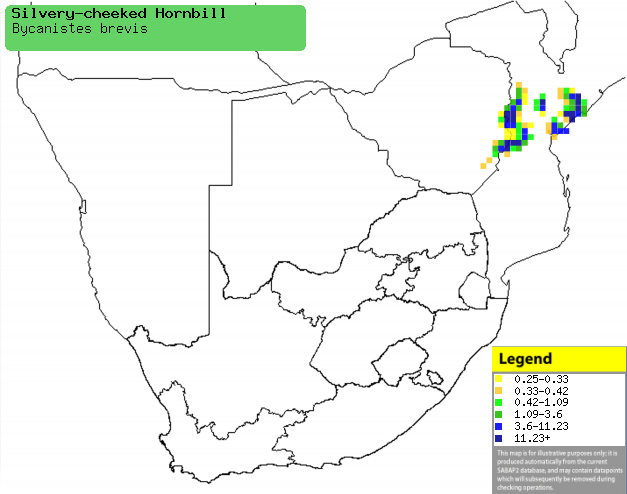|
Bycanistes brevis
(Silvery-cheeked hornbill)
Kuifkopboskraai [Afrikaans]; Zilveroor-neushoornvogel
[Dutch]; Calao à joues argent [French]; Schopfhornvogel, Silbenwangen-hornvogel
[German]; Calau-de-crista [Portuguese]
Life
> Eukaryotes >
Opisthokonta
> Metazoa (animals) >
Bilateria >
Deuterostomia > Chordata >
Craniata > Vertebrata (vertebrates) > Gnathostomata (jawed
vertebrates) > Teleostomi (teleost fish) > Osteichthyes (bony fish) > Class:
Sarcopterygii (lobe-finned
fish) > Stegocephalia (terrestrial
vertebrates) > Tetrapoda
(four-legged vertebrates) > Reptiliomorpha > Amniota >
Reptilia (reptiles) >
Romeriida > Diapsida > Archosauromorpha > Archosauria >
Dinosauria
(dinosaurs) > Saurischia > Theropoda (bipedal predatory dinosaurs) >
Coelurosauria > Maniraptora > Aves
(birds) > Order: Bucerotiformes >
Family: Bucerotidae
Distribution and habitat
Occurs in patches from Ethiopia, through Kenya and Tanzania
to northern and central Mozambique. It generally prefers patches of montane and
coastal forest patches, as well as tall woodland and gallery forest.
|
 |
|
Distribution of Silvery-cheeked hornbill in southern Africa,
based on statistical smoothing of the records from first SA Bird Atlas
Project (©
Animal Demography unit, University of
Cape Town; smoothing by Birgit Erni and Francesca Little). Colours range
from dark blue (most common) through to yellow (least common). |
Predators and parasites
Movements and migrations
Nomadic, moving in search of fruiting trees.
Food
Mainly eats fruit, doing most of its foraging in the forest
canopy, plucking fruit and occasionally catching prey such as bats and insects. The following food items have been recorded
in its diet:
- Plants
- fruit
- Ficus (figs)
- Syzygium (waterberries)
- Dracaena (dragon-trees)
- Newtonia (newtonias)
- Khaya anthotheca (Red mahogany)
- Strychnos (monkey-oranges)
- flowers of Cussonia spicata (Cabbage tree)
- Animals
Breeding
- Monogamous solitary nester, defending a small territory in the
immediate vicinity of the nest.
- The nest is a natural cavity in a trunk or large branch of a tree, such
as Mountain craibia (Craibia brevicaudata), often reused in multiple
breeding seasons. The entrance is sealed with mud pellets with the female
inside, leaving just a thin slot through which the male can pass food.
- Egg-laying season is from September-April.
- It lays 1-2 eggs, which are incubated solely by the female for about 40
days, while the male brings her food regularly.
- The chicks and female are fed by the male throughout the 77-80 day long nestling
period; at this point the seal is broken so that the
female and fledglings can leave.
Threats
Vulnerable in Zimbabwe, largely due to its
vulnerability to logging and slash-and-burn agriculture.
References
-
Hockey PAR, Dean WRJ and Ryan PG 2005. Roberts
- Birds of southern Africa, VIIth ed. The Trustees of the John Voelcker
Bird Book Fund, Cape Town.
|
